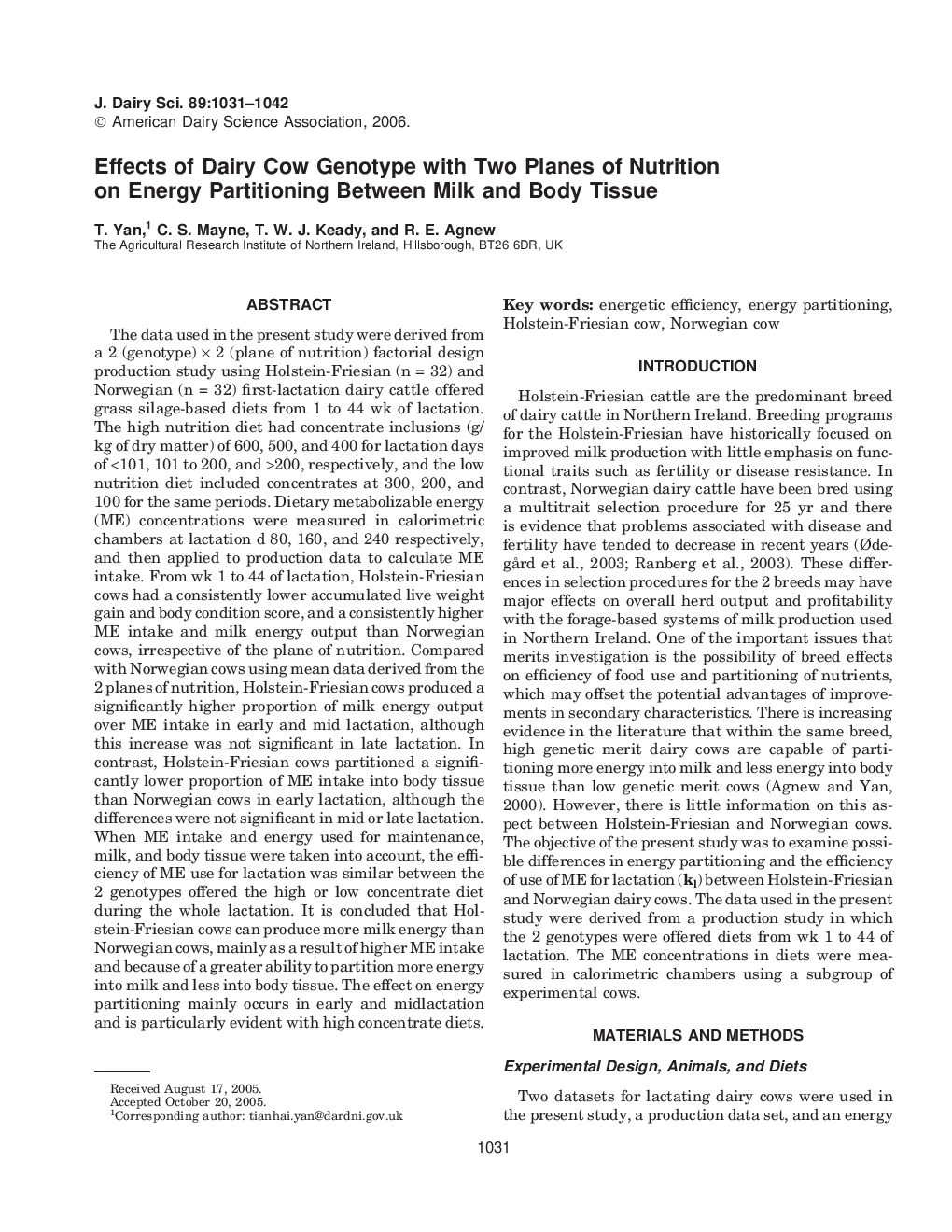| کد مقاله | کد نشریه | سال انتشار | مقاله انگلیسی | نسخه تمام متن |
|---|---|---|---|---|
| 2441636 | 1108146 | 2006 | 12 صفحه PDF | دانلود رایگان |
عنوان انگلیسی مقاله ISI
Effects of Dairy Cow Genotype with Two Planes of Nutrition on Energy Partitioning Between Milk and Body Tissue
دانلود مقاله + سفارش ترجمه
دانلود مقاله ISI انگلیسی
رایگان برای ایرانیان
موضوعات مرتبط
علوم زیستی و بیوفناوری
علوم کشاورزی و بیولوژیک
علوم دامی و جانورشناسی
پیش نمایش صفحه اول مقاله

چکیده انگلیسی
The data used in the present study were derived from a 2 (genotype) Ã 2 (plane of nutrition) factorial design production study using Holstein-Friesian (n = 32) and Norwegian (n = 32) first-lactation dairy cattle offered grass silage-based diets from 1 to 44 wk of lactation. The high nutrition diet had concentrate inclusions (g/kg of dry matter) of 600, 500, and 400 for lactation days of <101, 101 to 200, and >200, respectively, and the low nutrition diet included concentrates at 300, 200, and 100 for the same periods. Dietary metabolizable energy (ME) concentrations were measured in calorimetric chambers at lactation d 80, 160, and 240 respectively, and then applied to production data to calculate ME intake. From wk 1 to 44 of lactation, Holstein-Friesian cows had a consistently lower accumulated live weight gain and body condition score, and a consistently higher ME intake and milk energy output than Norwegian cows, irrespective of the plane of nutrition. Compared with Norwegian cows using mean data derived from the 2 planes of nutrition, Holstein-Friesian cows produced a significantly higher proportion of milk energy output over ME intake in early and mid lactation, although this increase was not significant in late lactation. In contrast, Holstein-Friesian cows partitioned a significantly lower proportion of ME intake into body tissue than Norwegian cows in early lactation, although the differences were not significant in mid or late lactation. When ME intake and energy used for maintenance, milk, and body tissue were taken into account, the efficiency of ME use for lactation was similar between the 2 genotypes offered the high or low concentrate diet during the whole lactation. It is concluded that Holstein-Friesian cows can produce more milk energy than Norwegian cows, mainly as a result of higher ME intake and because of a greater ability to partition more energy into milk and less into body tissue. The effect on energy partitioning mainly occurs in early and midlactation and is particularly evident with high concentrate diets.
ناشر
Database: Elsevier - ScienceDirect (ساینس دایرکت)
Journal: Journal of Dairy Science - Volume 89, Issue 3, March 2006, Pages 1031-1042
Journal: Journal of Dairy Science - Volume 89, Issue 3, March 2006, Pages 1031-1042
نویسندگان
T. Yan, C.S. Mayne, T.W.J. Keady, R.E. Agnew,